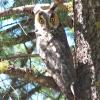Leaderboard
Popular Content
Showing content with the highest reputation on 01/01/2017 in all areas
-
Happy New Years, everyone. Just to throw in my 0.05 cents (what with inflation and all), Not only are there home territories when you shake out the data, sightings (at least in the northeast) appear to proceed in a random checkerboard patter. By that I mean, you'll get a series of sightings in one 400 square mile area, then nothing in the locale for 10 years, then a group of sightings a good 30 or 40 miles distant. The logical explanation is that, like slash-and-burn Amazon farmers, is that they deplete the food sources in an area, then move off to another area that has been untouched. I have no idea where they go in the interim, though. Just checked my database - the first possible female sighting (inferred due the size difference between two seen together) is 1940; after that nothing until 1972, although my source for that is Bobbi Short's Bigfoot Encounters. There is a story which an ill Indian told Pierre Radisson about encountering a sleeping man and woman, each believed to be 7-feet tall and a tribe of humans that large in the NY-Canada area in the 1600s that I'm pretty sure was not used by anyone as a template for a Bigfoot story. Hi, keep all the county/state labels turned on to identify where encounters take place. It's a shame JG didn't have Google Earth - many of the encounters he logged, from far away, are more accurate in regards to location, than he could have known with the resources available in his time. Once you pinpoint locations, though, and are looking for patterns, I recommend turning off all the political boundaries and roads so you can see the terrain. I'm fairly certain Bigfoot doesn't care about human political boundaries. Also, you may want to Google/Bing random maps on precipitation, topography, etc. For example, I did that for the northeast and found out that there's a "bridge" of higher ground connecting two mountain ranges in upper New York and Vermont. Nothing along that ridge but some little towns called Whitehall, Castleton, and Rutland. See above - sometimes it takes some time just staring and clicking things on (like political sub-division lines). Then all of a sudden you see that a sentence in a report that makes no sense whatsoever is dead on.1 point
-
Oh, our perception of counter-intuitive behavior is all on us. We, and I include myself - think/thought we were the apex predators - and that was one very uncomfortable realization. We look at their bulk and assume they'd be clumsy, maybe slow, possibly uncoordinated to a degree - and the opposite is true. Fast, very coordinated, and have the ability to go into stealth mode at will - much better than we can. That's a real eye-opener. Nothing like I would have expected. We look at their primitive appearance, and assume they're dumb. Just a big, dumb animal. Just the opposite - very clever, very adapted to their environment, and skilled enough to avoid us at will, although I think some of the youngsters get careless time to time and get spotted. But even they can cover lots of ground fast, and quickly disappear. We think we can surely see something so large if one is around. BS. Masters of camouflage, masters at concealing themselves low and in the shadows. And don't forget to look up in the big stuff! And since only one is seen as a general rule - it would be natural to assume they're somewhat loners. Another big mistake. We only see the one they wish to show - and just like the ape families, and just like the human families - both are very social creatures. There are a few exceptions in each, but the bulk like and prefer contact with others, and it helps by sharing the workload/tasks that working together provides. Counter-intuitive to be sure. But that's our fault.1 point
-
No, not really. The key is finding the location where some bigfoot or other will pass at a predictable enough time that you can anticipate and "ambush". It's the same scheme I used when I was guiding. We never target a specific fish. We identify places where fish are most probably going to be at the time we wish to fish and catch whichever ones are present when we get there. To some degree, the reason the old time footers didn't find bigfoot was they were chasing reports of individuals who'd already left instead of positioning themselves in advance of the next bigfoot to come along. Reactive instead of proactive. They didn't have the data we do. It's still spotty but in some places it is enough to make a heck of a start. MIB1 point
-
I agree to some extent they are counter-intuitive in our expected behavior. But is lack of expected behavior on their part their problem or ours? We just do not know them well enough to predict behavior. My experiences went from starting with peek and withdraw to ending with zapping and trying to drive me out of the woods with playfulness episodes in between. But one behavior on my part seemed to elicit the same response from different BF because of the geographical separation of the incidents. Go deep in their territory and in full view of one of them, urinate. That elicited the same response (chest slapping) both times. That indicates at least one behavior on the part of humans that is unacceptable on their part. I fully expected after the first contacts, like some forum members report, that I would become buddies with that family group. I was all but promised by certain forum members that if I did not display cameras that would happen. That did not happen. In their defense I was hunting them and likely they knew it, and each encounter got more unsettling for me because their behavior became more unfriendly. I think you could learn their behavior if you could maintain contact for decades with the same family group. Logging terminated my association with one group. Perhaps the lesson from that is get deep into a national forest where logging is pretty much not allowed any more and find a group that will interact. Then expect it to take decades to learn much at all. Call it the Jane Goodall approach or whatever. FarArcher touches on something that is perhaps a hidden danger. Since we know so little about their daily behavior, it is very likely someone could stumble into something that is totally unacceptable to BF. . Young juvenile alone, a nesting area, a birthing area, or just cornering one that has no way out, might be a situation that triggers violent behavior on their part. We see that with bears so why expect anything different from BF? Should you have repeated contact, I would suggest that you enter their area carefully and with some predictability on your part. If you get in, have contact, and get out without problems, you probably could repeat that behavior on your part and not expect trouble. That first contact with any group of them is probably the most dangerous. The male leader might have had a bad experience with humans and is just waiting for payback. Perhaps that is where we see humans going missing?1 point
-
Well described, FA. Uncanny speed could answer many instances of perceived unexplained behavior.1 point
-
Somewhere in time on one of these threads, I'm pretty sure I stated my belief that these things can run down the fastest NFL player in short order. You noted the same thing I did - they are unbelievable fast - something just looking at them would seem counter-intuitive. I'd say the one you're aware of is not the one you should fear the most. These things can 'elect' to move quite quickly - silently - and I have no idea how they do that. So if one is letting you be aware of their presence - this just may be the 'driver.' The quiet one will be the one behind or on your flank you're not aware of. Sometimes, I believe, they're "herding" folks in the direction they want them to go - usually to egress the area. Other times, they're trying to create fear in someone, encouraging them to leave the area on their own. But I'd bet one won't be allowed to go where they don't want you too.1 point
-
It's an interesting question but I don't see anything new being added, just a rehash of the same old stuff. The bottom line is we don't know. They are not just dropping dead and decomposing on the surface to be found. If that were happening we'd have found some. We don't have those deep cold water springs here. Most of "my" area is too far from lakes for those to be a possibility. It is sedimentary rock country .. in other words, no caves. The couple small areas with caves are, like the lakes, too far to account for more than a fraction and most of the caves have been explored. The eastern edge of the area is volcanic but the rock is andesite primarily ... not the sort of flow lava that creates tubes. Most of the mining area is placer, not hard rock, so there are few mine shafts. If there is a one size fits all option, the most likely is hand-dug graves in softer soil, maybe in very brushy locations, that are carefully camouflaged, perhaps several times so they STAY hidden. Those 2 roars I heard in 2012 ... might maybe have been grief from a loss. That is, assuming they were sasquatch at all. I'm still not confident enough that I'd bet lunch money on it .. but now I wouldn't really bet lunch money against it either. If it was NOT bigfoot ... I want a bigger gun. (That's not intended to be funny.) I think Randy / SWWASAS has a good opportunity. I think large scale natural disasters like the eruption of Mt St Helens present a chance for accidental burial and eventual weather-based un-burial. Definitely worth looking into by walking stream banks. There are rumors, but no strong evidence, of BF killed by fires. Most of us are probably ahead to look at other kinds of data since we don't know precisely what to look for or the kinds of places to look at in our particular areas. We stand some chance of bumping into an upright, moving bigfoot. That continues to happen to people. I don't think we stand nearly as much chance of finding a dead one since that has not happened yet. ... just looking at history and playing the percentages. MIB1 point
This leaderboard is set to New York/GMT-05:00




